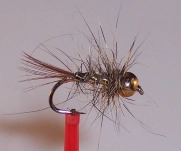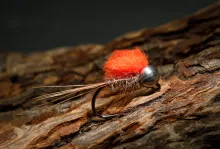It might seem futile to try to improve one of the world's most proven patterns, but there's room for improvement. Trevor Morgan gives some classics an overhaul.
For generations the Gold Ribbed hare's Ear has been in nearly every fly fisher's fly box. It has been such a reliable fly.
With may years of fly fishing experience I noticed that flies with a body which had a good number of guard hairs - caught much more fish. For those of you not familiar with fur, there are spiky outer hairs often referred to as "guard hairs" and fluffy fur called "underfur". A good fly body needs both but with much more of the guard hairs. Underfur tends to mat after being wet and is not so lifelike. Guard hairs represent the legs of a fly and, are very effective in catching trout and grayling, which after all is the object of the exercise!
Fox squirrel pelt
So it was that after experimenting with a fox squirrel pelt that I noticed that the entire body or pelt was covered with guard hairs. When we consider that an actual hare's ear has only a limited number of these, then, here is a bonanza!
I have introduced fly bodies dubbed from this fur to a few well known flies and consequently the results from fishing with these flies have been very significant. They are the actual Gold Ribbed Hare's Ear made from Fox Squirrel. The gold and copper head versions of this, the thorax of the Pheasant Tail nymph, and a new fly created by me - "The Morgan's Ear."
It is the more pronounced use of guard hairs which produce a " buggy" effect that has improved the attractiveness of the flies.
Dubbing the body
Well wax the silk beforehand. Then take several pinches of fur from the Fox Squirrel pelt and put them on the table. Gather these together, rolling lightly into a long thin finger and offer to the silk. Always rotate in the same direction (clockwise) between finger and thumb, until the finger of fur has formed around the silk.
I now use a turbo dubbing tool, or similar device and spin to create a dubbing rope. The thickness of this can vary accordingly, so you can be creative.
Next wind along the shank of the hook to create the body. Ribbing materials may vary but for the GRHE, I use a fine flat gold (Uni no. 16) and it is important to rib with 3-4 equally spaced, parallel turns. When this is done the trapped guard hairs can be picked out with a pin.
I hope this gives some idea of the use of this material. On flies like the Pheasant Tail Nymph, it has given the thorax a "buggy" appearance. If you look at the photo , you can see the actual wing case is a darker, different colour to the body. This is a technique which I call "the reverse wing case technique" and can give details of this in a future article.
However I will give more on the "Morgan's Ear" - a fly which I created about nine years ago and which has proved to be a very prolific fly for both trout and grayling. It is primarily a river fly but has done well on still waters when trout are feeding on surface flies.
Over the years fishing with this fly I have experienced that flies with the following features catch much more fish.
- The wing should be no longer than the bend of the hook and a wedge shape. You can trim this with scissors.
- A body with a good number of guard hairs will be most successful.
- The rib - 3-4 evenly spaced turns gives the impression of a segmented, living fly body.
For those of you who have never fished with CDC dry flies; never, ever, use floatant!
The fly will sink like a stone! The CDC will float for long periods without treatment, and after landing a fish, just press the fly against an absorbent bit of cloth or amadou - and it will continue to float.
This fly works well when Olives are hatching, but even when nothing seems to be rising, this is a fly that will tempt fish to come up!
It is a good general purpose fly, which has done well from Slovenia to Scotland, and Ireland. There are now several hundred fly fishers using this fly and all those who use it, swear by it.
Could you also experience the same success?
A comment
David Willcox writes:
I fish regularly with Trevor Morgan and during one of our telephone conversations this morning he mentioned his conversation with you about Morgan's Ear, the fly he developed a few years ago. I hope this is not too presumptious of me but as a regular user of the fly I thought it might help if you received some comments from an enthusiast of the fly.
I met Trevor Morgan about 5 years ago; fellow directors had bought me one of his rods as a retirement present and since Trevor offered training on up-stream dry fly fishing on a chalk stream in Hampshire it was good opportunity to learn this advanced skill on some of the best water in the UK.
His training was good, a relaxed and patient approach, in a practical situation and since I caught a number of trout on my first outing it was clearly effective too.
I was introduced to his design of a new dry fly, the Morgan's Ear on my first day and it has been a big success, I have used it consistently since then and I would say now that I have caught more trout on this fly than on all other dry patterns put together. It is an outstanding fly during the summer months both during the day and the evening rise.
I would say now that I have caught more trout on this fly than on all other dry patterns put together
The wedge shape of the CDC wing completes a good silhouette of a surface fly and ensures it will float consistently. The longer "guard" hairs obtained from the Fox Squirrel, represent the legs of the insect they have a definite "buggy" appearance. This coupled with the ribbing, 2-3 turns, equally spaced, parallel, thin flat gold, give a good impression of a segmented, living insect body. I have now come to rely on the fly as a staple requirement in my fly box and I would not be without it.
- Log in to post comments














I not only learned f
I not only learned fly fishing from Trevor, I also fish with him regularly in still waters and rivers. My first trout caught on dry fly was on a Morgans Ear and since then I always carry some in my flybox. I caught trouts and graylings in almost every water and weather condition on this fly during the last seasons. I fished this fly very successfully all time from the beginning of the trout season right into some winter grayling sessions.
Like Peter I am using Trevor s Javelin flylines in 5 weight for rivers and a seven weight for most of my stillwater fishing and can strongly recommend them.
Now I am really looking foward to fish with Trevor again on a beautiful chalkstream next weekend.
I have been using th
I have been using the fox squirrel version of the GRHE ever since Trevor introduced it to me about 18 months ago. I am convinced it is a more effective pattern for both casting to sighted fish and general prospecting.
For a change I also like to tie it with a pearl rather than gold rib and with a copper bead. For winter grayling trips in relatively clear, fast water this pattern really comes into its own and I carry a few with a tungsten bead and lead wire for when there is a real need to go deep.
The Morgan's Ear is a simple pattern but one that I too have found effective throughout the season, particularly to imitate olives, grannom and general sedge. If I was restricted to two dry flies for fishing outside the mayfly I would opt for this one and an olive JG Emerger, that I find is devastatingly effective on all chalkstreams.
For those that haven't tried one of Trevor's Javelin flylines, they are strongly recommended. I use a five weight for rivers and for reservoirs, his 10ft rod coupled with a seven weight javelin throws a team of flies a long way. The rod has plenty of power, but is also remarkably sensitive.
Peter Laurie